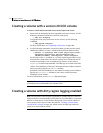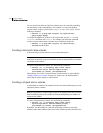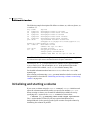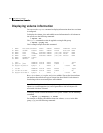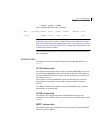
260 Creating volumes
Initializing and starting a volume
The following sample description file defines a volume, db, with two plexes, db-
01 and db-02:
#rty #name #options
sd mydg03-01 disk=mydg03 offset=0 len=10000
sd mydg03-02 disk=mydg03 offset=25000 len=10480
sd mydg04-01 disk=mydg04 offset=0 len=8000
sd mydg04-02 disk=mydg04 offset=15000 len=8000
sd mydg04-03 disk=mydg04 offset=30000 len=4480
plex db-01 layout=STRIPE ncolumn=2 stwidth=16k
sd=mydg03-01:0/0,mydg03-02:0/10000,mydg04-01:1/0,
mydg04-02:1/8000,mydg04-03:1/16000
sd ramd1-01 disk=ramd1 len=640
comment=”Hot spot for dbvol
plex db-02 sd=ramd1-01:40320
vol db usetype=gen plex=db-01,db-02
readpol=prefer prefname=db-02
comment=”Uses mem1 for hot spot in last 5m
Note: The subdisk definition for plex, db-01, must be specified on a single line.
It is shown here split across two lines because of space constraints.
The first plex, db-01, is striped and has five subdisks on two physical disks,
mydg03 and mydg04. The second plex, db-02, is the preferred plex in the
mirror, and has one subdisk, ramd1-01, on a volatile memory disk.
For detailed information about how to use vxmake, refer to the vxmake(1M)
manual page.
After creating a volume using vxmake, you must initialize it before it can be used.
The procedure is described in “Initializing and starting a volume created using
vxmake” on page 261.
Initializing and starting a volume
If you create a volume using the vxassist command, vxassist initializes and
starts the volume automatically unless you specify the attribute
init=none.
When creating a volume, you can make it immediately available for use by
specifying the -b option to the vxassist command, as shown here:
# vxassist -b [-g diskgroup] make volume length layout=mirror
The -b option makes VxVM carry out any required initialization as a
background task. It also greatly speeds up the creation of striped volumes by
initializing the columns in parallel.



